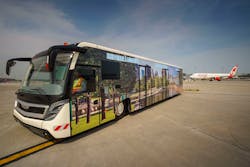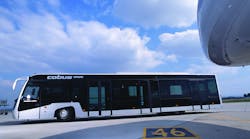Handle More Flights with Less Capital Investment
The COBUS Airside Bus is a purpose designed vehicle specifically to move large groups of people over relatively short distances. It is intended to operate on airport tarmacs, on the AOA – Aircraft Operating Areas. Uses of the COBUS include shuttling passengers between the airport terminal and aircraft parked away from the terminal gates on hardstands. The COBUS is used to move passengers between terminals inside the security zones thus eliminating the need to go through airport security multiple times when transferring from one terminal to another.
Airports have found that by implementing COBUS Airside Buses into their planning, they can accommodate significantly more aircraft arrivals and departures than they have physical gates available. Parking aircraft on hardstands away from the terminal building and accessing the aircraft with mobile stairs or ramps, the airport can increase the number of flights serving the airport. Passengers ride in climate controlled, secure COBUS buses for the short – usually 5 minutes or so – ride between the aircraft and the terminal.
Airports have found that using hardstands allows not only more flights, but also a significant savings in both time and cost to increase their daily flight schedules. While the planning, design and construction of additional aircraft gates at the terminal can require several years and millions of dollars, the implementation of hardstand operations can be inaugurated in several months. The elimination of the physical expansion of the terminal building and the time savings factor is almost incalculable. The cost of a hardstand operation is a fraction of the cost of a brick and mortar project.
Why COBUS? The COBUS Airside Bus has been specifically designed for the purpose of operating on an airport ramp. The several models available accommodate between 75 and 110 passengers. Entry to the bus is safe and easy – just one short step up from the ground through several double-wide doors located on each side of the bus onto a wide flat floor. The COBUS is designed in accordance with the parameters defined by IATA for airside passenger buses.
The COBUS is constructed almost entirely of aluminum, thereby eliminating potential deterioration. The body structure is warranted for 20 years – a feature not offered by any other vehicle manufacturer. Motive power is available to choice: ultra-low emission diesel or fully electric, and we are working on the potential for a hydrogen powered COBUS. As airports become more and more concerned with their impact on the environment, it is important to note that even the COBUS diesel engine consumes only two gallons of fuel per operating hour compared to the five or more gallons used by typical transit buses.
Fully electric operation has been offered by COBUS since 2014. Battery charging is accomplished by the airports’ choice of charging systems. From quick charge requiring less than two hours to an overnight recharge, operators have the ability to define the best system for their fleet based upon intended routes and hours of usage. Experience has shown that vehicle maintenance requirements of electric COBUS buses is considerably less that that of other power options. This offers additional savings to airports and operators of COBUS electric buses.
When airports and/or airlines begin COBUS operations, they are provided with full maintenance support and training for their maintenance and operations staffs. COBUS Field Service Engineers arrive at the airport together with the new COBUS. It is their job to commission the buses, ensuring that full operational capabilities are available within a few days after arrival. They provide training to both airport maintenance personnel and to the drivers of the buses. Training is also provided to supervisory staff in both disciplines. Spare parts are delivered and defined. Service check schedules are reviewed with all concerned. Replacement spare parts are generally available on an overnight basis or no later than several days after order.
COBUS Airside Buses have been in operation for 35 years, now at 400 airports around the globe including many here in North America. Of the more than 4,000 COBUS buses operating around the world, there are over 300 in the U.S. and Canada alone.
In summary, the advantages that COBUS Airside Buses bring to an airport can be stated to be:
- The ability to handle more flights without significant capital investment in terminal expansion
- The rapid and expeditious movement of passengers between terminals and aircraft parked off-gate on hardstands
- The ability for airports to determine the best scenarios for additional aircraft movements beyond fixed terminal gate capacities.
- To maintain capacity and add flexibility during airside construction
- Ad hoc passenger transport requirements such as retrieval from aircraft immobilization on runways or taxiways, IROPS/ERPS
For more information about COBUS Airside Buses, please call Don Frassetto, President, COBUS Industries LP, at 1-203-380-9575 or by email [email protected].






